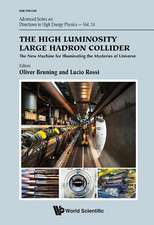Cooking as a Chemical Reaction
Autor Z. Sibel Ozilgenen Limba Engleză Hardback – 24 iun 2019
With this book, students are able to perform experiments and then make observations that they will frequently see in the kitchen and other food preparation and processing areas and learn the science behind these phenomena. The second edition of Cooking as a Chemical Reaction: Culinary Science with Experiments features new chapters on food hygiene and safety, kitchen terminology, and taste pairing, as well as an expanded chapter on the role of food additives in culinary transformations.
The text uses experiments and experiences from the kitchen, and other food preparation areas, rather than theory, as the basic means of explaining the scientific facts and principles behind food preparation and food processing. It engages students in their own learning process. This textbook is designed so that students can first perform certain experiments and record their observations in tables provided in the book. The book then explains the science behind their observations.
Features:
- Experiments and recipes form the basic means of teaching culinary chemistry
- Features new chapters on food hygiene and safety, kitchen terminology, and taste pairing
- Employs real kitchen practices to explain the subjects
- Covers traditional food chemistry including water in culinary transformations, protein, carbohydrates, fats, sensorial properties
Many concepts throughout the book are marked with a symbol that indicates the concept is one that they will come across frequently not just in this text, but in the kitchen and other food preparation and processing areas. A second symbol precedes the scientific explanation of the observation made during the experiments in the chapter. At the end of each chapter, students are presented with important points to remember, more ideas to try, and study questions to reinforce concepts that were presented in the chapter. The book is designed for each chapter to be read and studied in chronological order, as the concepts of each chapter will reoccur in subsequent chapters.
Written at the undergraduate level, this book is designed for students in culinary arts, nutrition, dietetics, food science and technology, and gastronomy programs. It is intended for students with limited scientific background who are studying different aspects of food preparation and processing.
Preț: 673.22 lei
Preț vechi: 792.03 lei
-15% Nou
128.82€ • 134.86$ • 106.59£
Carte tipărită la comandă
Livrare economică 05-19 aprilie
Specificații
ISBN-10: 1138597120
Pagini: 410
Ilustrații: 303 Halftones, black and white; 31 Illustrations, black and white
Dimensiuni: 178 x 254 x 25 mm
Greutate: 0.54 kg
Ediția:2nd edition
Editura: CRC Press
Colecția CRC Press
Cuprins
Acknowledgments
Author
1 Measurements and Units
2 Basic Food Chemistry
3 Water in Culinary Transformations
4 Carbohydrates in Culinary Transformations
5 Proteins in Culinary Transformations
6 Fats and Oils in Culinary Transformations
7 Keys to Developing the Perfect Bite: New Food Product Development and Sensory Evaluation Tests
8 The Science of Flavor and Flavor Pairing
9 Food Additives in Culinary Transformations
10 Food Safety and Hygiene in Culinary Transformations
Extended Glossary
Index
Descriere
With this book, students are able to perform experiments and then make observations that they will frequently see in the kitchen and other food preparation and processing areas and learn the science behind these phenomena. The second edition of Cooking as a Chemical Reaction: Culinary Science with Experiments features new chapters on food hygiene and safety, kitchen terminology, and taste pairing, as well as an expanded chapter on the role of food additives in culinary transformations.
The text uses experiments and experiences from the kitchen, and other food preparation areas, rather than theory, as the basic means of explaining the scientific facts and principles behind food preparation and food processing. It engages students in their own learning process. This textbook is designed so that students can first perform certain experiments and record their observations in tables provided in the book. The book then explains the science behind their observations.
Features:
- Experiments and recipes form the basic means of teaching culinary chemistry
- Features new chapters on food hygiene and safety, kitchen terminology, and taste pairing
- Employs real kitchen practices to explain the subjects
- Covers traditional food chemistry including water in culinary transformations, protein, carbohydrates, fats, sensorial properties
Many concepts throughout the book are marked with a symbol that indicates the concept is one that they will come across frequently not just in this text, but in the kitchen and other food preparation and processing areas. A second symbol precedes the scientific explanation of the observation made during the experiments in the chapter. At the end of each chapter, students are presented with important points to remember, more ideas to try, and study questions to reinforce concepts that were presented in the chapter. The book is designed for each chapter to be read and studied in chronological order, as the concepts of each chapter will reoccur in subsequent chapters.
Written at the undergraduate level, this book is designed for students in culinary arts, nutrition, dietetics, food science and technology, and gastronomy programs. It is intended for students with limited scientific background who are studying different aspects of food preparation and processing.



















